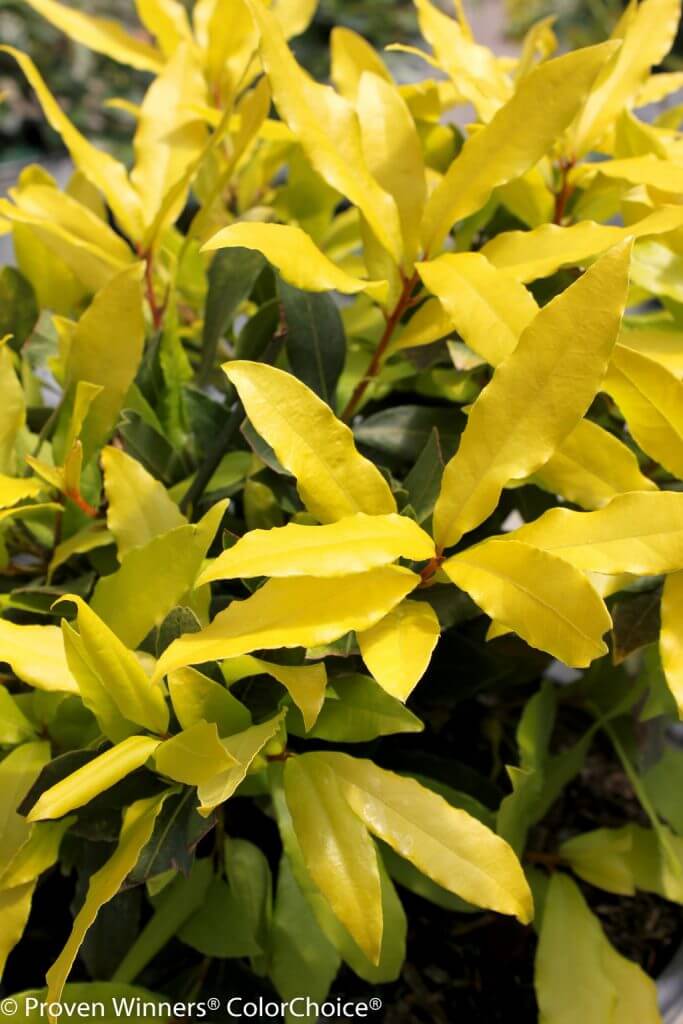
Bay laurel (Laurus nobilis) is a historic Mediterranean evergreen that plays multiple roles in the garden. Where hardy, in USDA Hardiness Zones 8-10, it serves as a fine specimen tree or tall hedge. In colder climates, it makes an attractive house plant and summer patio specimen. And, wherever it’s planted it serves as an essential culinary herb. Dried, bottled bay leaf from the store cannot compare to fresh.
Bayleaf, a Noble History

The name “nobilis” denotes the ancient, noble history and importance of bay laurel to royalty, in ceremony, and in mythology, particularly in Greece, as well as Rome, Egypt and Asia.
The Greeks considered the tree sacred, protective, pure, and a symbol of victory. Bay oil was used in the hair, wreaths and headpieces were fashioned from the glossy fragrant leaves, and food was flavored with them. Apollo, the mythical Greek God of Sun and Light, wore a crown of bay leaves to celebrate his slaying of the great underworld dragon-like God, Python.
Nobles, champions, and the first Olympians were crowned with garlands of bay laurel. Bay was also essential to the prophetic Greek priestess Pythia, the Oracle of Delphi of Apollo’s sanctuary. Branches were brought as offerings, scented the sanctuary, and the leaves were chewed by the priestess as she conjured prophecies.
Bay Laurel for Homes and Gardens

Bay leaf is easy to grow indoors, if you have a sunny spot that remains relatively cool in winter. At the garden center, choose a leafy, vigorous tree, and plant it a deep ceramic pot that’s twice the width of the root ball. Leave at least 2 inches of space at the top for watering. We recommend planting bay in a rich, well-drained potting mix for edible growing, like Fafard® Natural & Organic Potting Mix, which is approved for organic gardening.
During the summer months, bay pots grow better outdoors and require more water. Water less in fall and winter, but don’t let the pot become completely dry between watering. Transplant your bay laurel in a pot that’s twice the size of its root ball when it outgrows its pot. As its branches grow, prune them back, if they become too large and top-heavy. Be sure to harvest and dry the leaves for cooking. You can harvest bay leaves all season long, Just be more sparing in winter when the plants are dormant and not producing more foliage.
Several pests can cause problems on indoor plants. These include hard scale, mealybugs, and spider mites. (Click here to learn how to manage house plant pests.)
Garden-Grown Bay Laurel

Where hardy, bay laurels are fine, resilient evergreen trees or shrubs. In spring, they bear clusters of yellow green flowers that are fragrant and pollinated by bees. The trees are dioecious, which means separate plants have male or female flowers. The female trees produce nearly black, single-seeded berries (in the presence of male trees) that are somewhat attractive but inedible.
Plant bay laurel in a location with full to partial sun and protection from high winds. It grows best in well-drained soil that holds water well. Amending your soil and planting time with quality Fafard Premium Natural & Organic Compost will encourage good growth and quicker establishment. (Click here for more tree-planting tips.). Established specimens tolerate drought, but don’t too much drought will results in stress signs such as leaf drop and poor growth. Large outdoor specimens are easily trimmed and sheared into topiaries.
Bay Laurel Varieties

Sicilian Sunshine Bay Laurel (Laurus nobilis Sicilian Sunshine®: The bright yellow leaves of this bay laurel are brightest when the leaves first emerge and in winter. Mature specimens can reach 10 feet. Potted specimens need regular pruning.
Little Ragu® Sweet Bay (Laurus nobilis lender leaves of this Little Ragu®): Despite its name, this bay laurel reaches 6 to 8 feet after 10 years. Still, it is slow-growing, bushy and the best for containers.
Saratoga Bay Laurel (Laurus ‘Saratoga’, Zones 8-11): ‘Saratoga’ is a cross between bay laurel and Azores laurel (Laurus azorica). The tree reaches 20-30 feet and has a beautiful round, dense canopy, and lighter green leaves. It makes a fine specimen tree for warmer climates.

